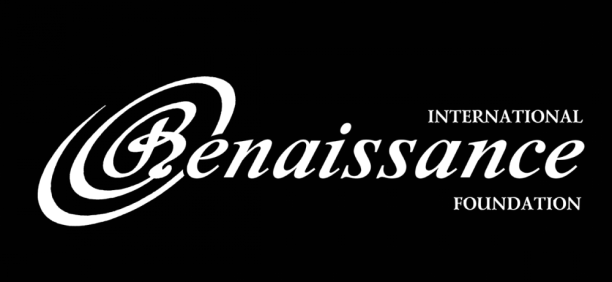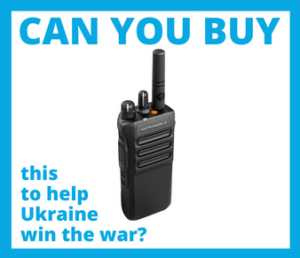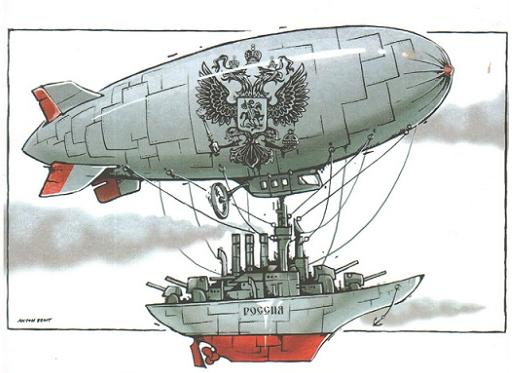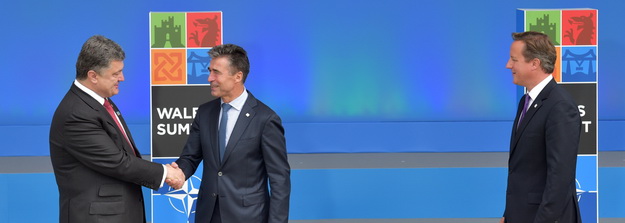Almost a year after Russia’s large-scale invasion of Ukraine, NATO is reconsidering its approach to deterring the primary continental aggressor. The concept of deterrence by retaliation is being replaced by another concept – deterrence by denial.
The previous concept stipulated that in the event of a Russian invasion, the member states of the North Atlantic Alliance had to hold out until allied forces arrived to help them and retaliate to push the aggressor back.
However, after Russia’s war crimes in the occupied territories of Ukraine, Eastern European countries are no longer ready to consider any Russian occupation of their territories as part of a deterrence strategy. So now the Alliance is changing its defense strategy and planning to further strengthen its eastern borders.
How will this affect NATO’s position, Moscow’s appetites, and Ukraine’s strategic role?
Nothing new under the sun
Considering the war experience in Ukraine, NATO considers deterrence by denial as the best option for counteracting Russian aggression that threatens Alliance cohesion and geographically vulnerable members such as the Baltic states.
Deterrence by denial means convincing an adversary that “an attack will not succeed because the defense is strong,” while deterrence by retaliation means threatening an adversary to “retaliate for an attack if it is carried out” to force the adversary to refrain from it.
Both of the Alliance’s defense concepts are not new and have been in place since the Cold War.
Since 1949, the main mechanism by which NATO sought to deter Soviet aggression was deterrence through retaliatory strikes by threatening to use nuclear weapons by three Allies: The United States, the United Kingdom, and France. NATO’s emphasis on “nuclear” deterrence was due to the assessment of the enormous numerical superiority of Soviet forces over its own.
NATO’s First Strategic Concept also introduced a second deterrence component: deterrence by preventing a strike by deploying adequate forward forces to protect the Alliance’s territory from invasion. In other words, NATO’s strategy of denial was a forward defense option designed to “stop the enemy from advancing as far west as possible.” It was also supported by active peacetime counteraction to aggression by “all measures not related to war.”
The assessment of Soviet intentions outlined above led NATO to adopt a “sword and shield” strategy in its 1957 Strategic Concept: a combination of strategic nuclear forces to deter attack through the threat of massive retaliation, along with the forward defense of NATO’s eastern front by basing significant forces as far east as possible.
Russia’s temporary occupation of Crimea in 2014 and the organization of terrorist groups in the Donbas region of eastern Ukraine have undermined the approach to defense that NATO has taken in Europe since 1991.
NATO’s initial response to the events of 2014 was to strengthen deterrence through reinforcements combined with a forward presence in the East.
At the Warsaw Summit in 2016, it reinforced its forward presence in Estonia, Latvia, Lithuania, and Poland by forming four multinational battlegroups. Thus, similar to the US forces in Europe, other NATO allies also demonstrated readiness for extended deterrence on the eastern flank, and the combat power of these formations was far from decisive.
Initially, NATO developed Graduated Response Plans (GRPs) that were geographically divided and covered segments of NATO’s borders from the North Atlantic through Central Europe to the Eastern Mediterranean. The main drawback of this response was NATO’s limited ability to think and act coherently within these units.
In this movement, the Alliance has shifted its emphasis to the immediate NATO Response Force (NRF) in the European theater and defense planning.
Given its vast geography, NATO has almost defaulted to a deterrence strategy of retaliation after 2014. Its military commanders have developed a coherent military strategy plan to implement this posture. However, a 2016 RAND study found, “NATO, as it stands, cannot successfully defend the territory of its most vulnerable members.”
An alternative would be deterrence by preventing a strike (deterrence by denial), for which analysts had to identify critical points where Russia could attack and build strong defenses around them.
NATO analysts believed that conventional actions against critical military targets or severe economic sanctions could be a means of deterrence through retaliation, provided that the costs to the enemy outweigh the benefits of aggression. This alternative is also attractive because it relies less on the ultimate deterrent of nuclear weapons, which is the most apocalyptic option given Europe’s population density.
These efforts began in 2014 with the so-called European Reassurance Initiative, which was transformed into the European Deterrence Initiative (EDI) in 2017. Spending on EDI increased from $1 billion in 2015 to $6.5 billion in 2018. This was followed by a multi-year decline to $3.8 billion in the (Fiscal Year) FY2022 budget, as Pentagon officials stated that “the initiative has achieved many of its goals.”
These measures allowed for the presence in the region of an entire armored brigade with support assets, a combat aviation brigade, and an Army battalion, as well as investments in supporting infrastructure, equipment, and training.
Madrid commitments
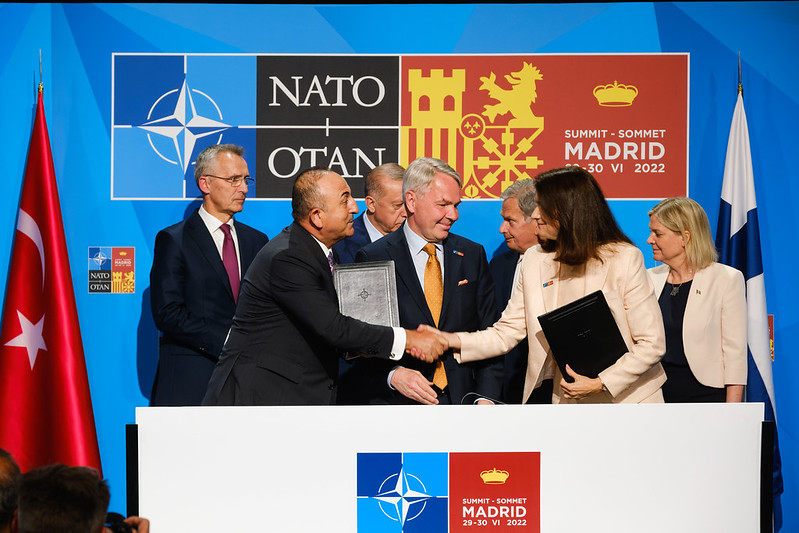
NATO’s “patchwork” adaptation to the new geopolitical realities after 2014 seemed to keep the strategic balance in Europe intact. However, Russia’s full-scale invasion of Ukraine on 24 February 2022 finally shattered this illusion.
From that moment, it became clear to almost all Allies that NATO’s defense doctrine had to change.
At the 2022 NATO Summit in Madrid, Allies adopted a new strategy and agreed to strengthen the Alliance’s defense and deterrence. NATO recognized Russia as a direct threat and declared that it would be able to defend “every inch of its territory” and “defeat any aggressor.” These goals are to be achieved through:
- a greater military presence on its eastern flank,
- the development of new regional plans,
- the allocation of dedicated forces to defend specific regions,
- and the maintenance of a much larger force with a higher level of collective defense readiness than before.
Strengthening the deterrence posture was a central issue at the June NATO summit in Madrid. It is also central to the new Strategic Concept, which commits to “deterring and defending on the front lines with robust, multidimensional, capable forces on the ground” – in other words, moving from “deterrence by stretch” in the East to Cold War-style forward defense.
The new Strategic Concept brings NATO’s nuclear sword back to the forefront – “reaffirming the unique and distinctive role of nuclear deterrence” – and turns the shield away from stretching forward presence to “deterrence and defense at the front lines with robust, capable forces operating in multiple domains.” The shift to deterrence by denial is not just about land defense – it also updates and expands the concept of the modern strategic environment, confirming that hybrid, cyber, or space-based attacks can “invoke Article 5 of the North Atlantic Treaty.”
First of all, the revision of approaches will involve a change in NATO’s defense strategy on its eastern flank (replacement or fundamental revision of the Readiness Action Plan, approved in 2014), followed by a revision of the current military strategy of the Alliance (MC 400/4), approved in 2019, and adaptation of the content of these documents to the fundamental concept of NATO’s warfare (currently approved in 2021). Thus, over the past year, NATO’s military leadership has been developing the doctrine, its goals and means necessary to counter the Russian threat, after the new strategic concept was approved in Madrid.
The political component of the Madrid Strategic Concept now needs to be reconciled with the current military strategy, which could create problems if one or more allies do not agree to the new terms of military planning. Since last year, the United States has been pushing its European allies to invest in their own deterrence capabilities, but “at the moment,” the Europeans have little to offer NATO in military and strategic terms.
The new military strategy will have to take into account new forms of confrontation in all domains (land, sea, air, space and cyberspace), as well as their traditional and non-traditional forms (hybrid warfare), which is a forward-looking vision in emphasis that now requires political justification among the 31 Allies.
Neither stronger defense and deterrence nor any of the ambitions of the Alliance’s new Strategic Concept will be possible without increased defense investment. A new defense investment commitment to replace the one made in 2014 will be high on the agenda of the further summit in Vilnius.
Despite the full-scale war in Europe, half of NATO’s 31 members are unlikely to reach the goal set at the 2014 Wales Summit this year, according to which Allies should increase defense spending to 2% of GDP by 2024.
The “deterrence by denial” strategy involves permanently deploying significant contingents of NATO troops near the border with Russia. For the first time since the Cold War, it also means integrating the military plans of the United States and its allies. In addition to strengthening NATO forces on the alliance’s eastern flank, it is also about making this strengthening financially and technologically tangible for Russia.
The transition to this concept also implies increased military spending to at least 2% of the GDP of NATO member states. It is assumed that if large NATO countries spend up to 3% of GDP on military spending over ten years, this will be enough to implement the new defense plan.
In practice, this means increasing the reliability of NATO’s nuclear forces, investing in forward defense by building up conventional forces, and strengthening the resilience of the eastern members of the Alliance to deter and counter all forms of Russian aggression.
At the NATO summit in Vilnius in July, Allies will take several organizational steps necessary to implement the Madrid Strategy and new defense plans:
- Implementation of sustainment programs to ensure that Allies have stockpiles sufficient to fight a prolonged conflict and that the defense industry is able to replenish them in a timely manner;
- Ensuring adequate funding for defense spending, including a commitment by NATO countries to allocate at least 2.5 percent of GDP as a minimum level of defense spending;
- Allies commanding battlegroups in countries bordering Russia should adopt a plan to increase their units to the level of brigades. To do so, NATO should unequivocally reject the military “self-restraints” contained in the 1997 NATO-Russia Founding Act on force posture in Europe;
- The United States should maintain its forces in Europe at the current level, which was increased in 2022. One of the practical consequences of the concept of deterrence by denial should be the increased role of the Supreme Allied Commander in Europe in terms of integrating American and allied warfighting plans.
Eastern Flank as NATO’s Achilles’ heel
The Baltic Sea region provides Russia with a number of opportunities to increase tensions on the verge of open conflict, provoke a “limited war” with NATO and threaten the Alliance with further escalation. There are Russian-speaking minorities in the Baltic states that can be used for provocations and used as a pretext for aggression.
The Kremlin’s vassalage relationship with the Lukashenko regime allows it to use Belarus as a proxy against NATO countries such as Poland, Lithuania, and Latvia. Russia can also use Belarusian territory, the Kaliningrad region, and its militarized exclave to close the so-called Suwalki corridor leading from Poland to the Baltic states, cutting them off from NATO reinforcements.
Until now, the Alliance’s defense concept has assumed that in the event of a conflict with Russia, Russian troops could temporarily occupy parts of NATO countries, such as the Baltic states or Poland. It was assumed that these territories would be liberated after the arrival of the main forces of the Alliance, primarily the United States. In addition, by 2014, the Alliance believed that a large-scale deployment of troops in the Baltic states would rather provoke a war, which they were designed to prevent.
In the new realities, based on the principle of deterrence by denial, NATO’s posture in the East must be strengthened both qualitatively – to counter specific Russian offensive capabilities, such as long-range artillery or missiles, and quantitatively – to match the scale of the Russian threat.
No matter how attractive it may sound to Polish or Baltic states’ citizens, it means that the Alliance will likely have to return to a more large-scale defense with so-called “forces in place.” This does not mean that NATO has to match Russian forces soldier-for-soldier in numbers, but it is likely to lead to a change in the amount of reserve training among more European Allies.
“In the next phase, we expect NATO to do some long-term planning on how it will deter Russia after Ukraine and provide resilience and confidence to countries that cannot do it on their own. This could be permanent basing or rapid readiness – the ability to deploy quickly instead of being stuck in a large base in one place. This is all subject to development, which I think is extremely important,” said Ben Wallace, UK Secretary of State for Defense, on 19 May 2022.
Since the Warsaw Summit in 2016, NATO’s deterrence and defense in Eastern Europe has been based on two components:
- an enhanced forward presence focused on Poland and the Baltic states
- a focused forward presence that includes the Black Sea region.
The reinforced forward presence included the deployment of four multinational battlegroups on a rotational basis in Poland, Estonia, Latvia, and Lithuania, a process that was completed by 2017. These forces operate under the coordination of NATO member states – Canada, Germany, the United Kingdom, and the United States.
Compared to the enhanced forward presence in the Baltic States, NATO’s dedicated forward presence in the southeast is much smaller. As for the presence under the Tailored Forward program, this initiative is based on a number of proposals put forward by Romania and covers the land, sea, and air domains.
Despite these measures, a 2016 RAND Corporation study found that “…Russia could seize Riga and Tallinn in 60 hours and that NATO would need to deploy at least seven brigades to the area to be able to counter it.” Kaliningrad possesses missile technology that could cut off timely NATO reinforcements in the Baltic states, which are necessary for a credible deterrent by denial. The area is already well covered by Russian weapons systems, so NATO’s four battlegroups and the Baltic states’ defense forces could easily be “incapacitated, neutralized or destroyed” before allied reinforcements arrive by land, sea, and air.
The military value of the multinational battalions created after 2016 is not high. Their size alone does not allow them to provide a reliable defense of the Baltic states against the armed forces of Russia’s Western Military District.
Their value lies in acting as a multinational stretch for any invasion, automatically involving a number of other NATO forces in defense of the Baltic states from the outset and putting NATO’s reputation as a defensive alliance at stake.
The accession of the two Scandinavian countries is important because NATO can use their land, sea, and airspace to access the Baltic Sea and the Baltic states. In addition, the Baltic states and other NATO members are actively rearming themselves with the necessary offensive capabilities rather than relying on the United States and the United Kingdom to break through Russia’s “missile dome” in Kaliningrad.
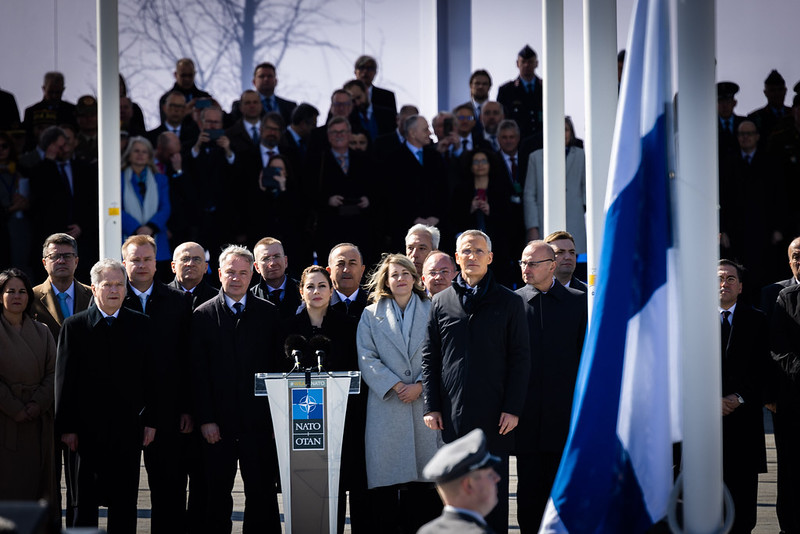
The new concept of deterrence by denial implies that NATO countries will seek to prevent occupying even a part of their territory. Naturally, it was Poland and the Baltic states that took into account the experience of the war in Ukraine, when in the first weeks of the invasion, Russia occupied large areas, and a numerous crimes against civilians were subsequently committed.
NATO should move to a full-scale preventive defense strategy, which will require strengthening the military capabilities of the eastern members of the Alliance. First of all, the Alliance is considering the construction of a secure infrastructure for aircraft at air bases in the Baltic States, so that the Alliance’s aircraft deployed in the region would be less vulnerable.
In addition, the “frontline countries” – especially Estonia, Latvia, Lithuania, Finland, and Poland – should receive enhanced defense capabilities, focusing on anti-tank weapons, to increase the potential costs Russia could incur in any limited military operations against them.
At the same time, increasing NATO’s forward presence in the East will not be an easy task. In Washington, there is currently broad bipartisan and public support for several significant military aid packages to Ukraine and the redeployment of more than 20,000 US troops to Europe. But the Taiwan crisis demonstrates the urgent need for the United States to focus on China, which may preclude an immediate increase in the presence of US troops in Europe.
Nevertheless, the US strategy stipulates that the US military must be able to fight a full-scale war in one geographic theater and deter another adversary in another. Therefore, European NATO members should be prepared for a worst-case scenario where a conflict in the Indo-Pacific region involves significant US resources. Under this assumption, European NATO members will have to allocate much more conventional capabilities to collective defense missions than they have been willing to do in the past.
Ukraine is becoming the key to the Black Sea region
After the occupation of Crimea and parts of Ukraine’s southern regions, Russia has strengthened its military capabilities in the Black Sea and is trying to take control of Ukrainian territorial or international waters to deny NATO access to the Black Sea region.
Potentially, Russia could provoke a crisis by attacking a NATO ship, present it as an act of self-defense, and, if the Alliance decides to reassure its allies and deter Russia by increasing its presence in the region, use it as a pretext for further escalation. Just as in the Baltic Sea region, Russia will use hybrid strategies to influence the threat perception of NATO populations and decision-makers and will use political divisions in NATO countries to delay or weaken the response to its actions.
Despite these obvious risks, and unlike the Baltic-Scandinavian frontier, the Alliance has one significant advantage in the southeast: Ukraine.
In the event of an attack on the countries of this region, Russia would either have to launch a large-scale amphibious operation from Crimea or first defeat the Ukrainian armed forces before crossing the border into Moldova and invading Romania, all of those “would require significant preparation, large forces and considerable time. As a result, NATO will have sufficient time to prepare a collective defense of the region,” according to the CEPA Task Group report.
At the extraordinary NATO summit in Brussels on 24 March 2022, it was decided to create four additional battlegroups in Slovakia, Hungary, Bulgaria, and Romania. Thus, the North Atlantic Alliance now has a total of eight battlegroups from the Baltic to the Black Sea.
Given the obvious insufficiency of these resources for the defense of member states in the Black Sea region, the Alliance’s support for Ukraine becomes even more strategically important, as it is thanks to the effective actions of the Armed Forces of Ukraine that Russia’s military potential has significantly decreased over the past year. Strengthening the Alliance’s forward presence in the Black Sea region also supports Ukraine by allowing member states to transfer weapons to it without fear of threat.
A year after Russia’s full-scale invasion of Ukraine, NATO has come to realize that the best response to Russia’s threat of escalation in the region is to supply Ukraine with the weapons systems it needs and possibly deploy them to “vulnerable countries” such as Moldova or Bosnia at their request.
***
After Russia’s full-scale military intervention in Ukraine a year ago, NATO is working on its own mistakes and actively promoting the process of transitioning its defense strategy from the logic of deterrence by retaliation to the logic of deterrence by denial.
The general direction of such reflection by the Alliance is logical, given the expansion of NATO’s territory to include Finland and (potentially) Sweden, which changes the strategic position in Northern Europe.
At the same time, these efforts and the more active position of Romania and Bulgaria are finally pushing the Alliance to develop a real defense strategy for the Black Sea region, which has historically been viewed as a “periphery” and left to Ankara.
So, let’s wait for these initiatives to be concretized at the NATO summit in Vilnius, which will take place soon.

Oleksandr Kalinichenko is a lawyer specializing in international law and head of the “Atlantist Notes” project
Related:
- Polish Senate calls for Ukraine’s rapid accession to NATO through extraordinary procedure
- Ukraine’s NATO dreams Hang in the balance as US and Germany hesitate – DPA

